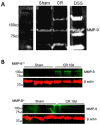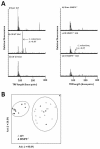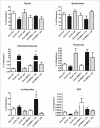Matrix metalloproteinase 9 contributes to gut microbe homeostasis in a model of infectious colitis
- PMID: 22694805
- PMCID: PMC3676156
- DOI: 10.1186/1471-2180-12-105
Matrix metalloproteinase 9 contributes to gut microbe homeostasis in a model of infectious colitis
Abstract
Background: Inflammatory bowel diseases are associated with increased expression of zinc-dependent Matrix Metalloproteinase 9 (MMP-9). A stark dysregulation of intestinal mucosal homeostasis has been observed in patients with chronic inflammatory bowel diseases. We therefore sought to determine the contribution of MMP-9 to the pathogenesis of Citrobacter rodentium-induced colitis and its effects on gut microbiome homeostasis.
Results: Wild-type and MMP-9-/- mice aged 5-6 weeks were challenged with C. rodentium by orogastric gavage and sacrificed either 10 or 30 days post-infection. Disease severity was assessed by histological analysis of colonic epithelial hyperplasia and by using an in vivo intestinal permeability assay. Changes in the inflammatory responses were measured by using qPCR, and the composition of the fecal microbiome evaluated with both qPCR and terminal restriction fragment length polymorphism. Activation and localization of MMP-9 to the apical surface of the colonic epithelium in response to C. rodentium infection was demonstrated by both zymography and immunocytochemistry. The pro-inflammatory response to infection, including colonic epithelial cell hyperplasia and barrier dysfunction, was similar, irrespective of genotype. Nonmetric multidimensional scaling of terminal restriction fragments revealed a different fecal microbiome composition and C. rodentium colonization pattern between genotypes, with MMP-9-/- having elevated levels of protective segmented filamentous bacteria and interleukin-17, and lower levels of C. rodentium. MMP-9-/- but not wild-type mice were also protected from reductions in fecal microbial diversity in response to the bacterial enteric infection.
Conclusions: These results demonstrate that MMP-9 expression in the colon causes alterations in the fecal microbiome and has an impact on the pathogenesis of bacterial-induced colitis in mice.
Figures







Similar articles
-
Probiotics are effective for the prevention and treatment of Citrobacter rodentium-induced colitis in mice.J Infect Dis. 2012 Jul 1;206(1):99-109. doi: 10.1093/infdis/jis177. Epub 2012 Mar 19. J Infect Dis. 2012. PMID: 22430833
-
Saccharomyces boulardii ameliorates Citrobacter rodentium-induced colitis through actions on bacterial virulence factors.Am J Physiol Gastrointest Liver Physiol. 2008 Jan;294(1):G295-306. doi: 10.1152/ajpgi.00173.2007. Epub 2007 Nov 21. Am J Physiol Gastrointest Liver Physiol. 2008. PMID: 18032474
-
Lactobacillus plantarum-derived extracellular vesicles from dietary barley leaf supplementation attenuate Citrobacter rodentium infection and intestinal inflammation.J Nanobiotechnology. 2025 Jun 7;23(1):426. doi: 10.1186/s12951-025-03504-w. J Nanobiotechnology. 2025. PMID: 40481571 Free PMC article.
-
Diet-induced expansion of pathobionts in experimental colitis: implications for tailored therapies.Gut Microbes. 2013 Mar-Apr;4(2):172-4. doi: 10.4161/gmic.23589. Epub 2013 Jan 18. Gut Microbes. 2013. PMID: 23333863 Free PMC article. Review.
-
An Unexplored Role for MMP-7 (Matrix Metalloproteinase-7) in Promoting Gut Permeability After Ischemic Stroke.Stroke. 2022 Oct;53(10):3238-3242. doi: 10.1161/STROKEAHA.122.040144. Epub 2022 Jul 29. Stroke. 2022. PMID: 35904018 Review.
Cited by
-
Salivary concentrations of secretory leukocyte protease inhibitor and matrix metallopeptidase-9 following a single bout of exercise are associated with intensity and hydration status.PLoS One. 2023 Nov 22;18(11):e0291297. doi: 10.1371/journal.pone.0291297. eCollection 2023. PLoS One. 2023. PMID: 37992002 Free PMC article.
-
Matrix Metalloproteinase-9 (MMP-9) induced disruption of intestinal epithelial tight junction barrier is mediated by NF-κB activation.PLoS One. 2021 Apr 7;16(4):e0249544. doi: 10.1371/journal.pone.0249544. eCollection 2021. PLoS One. 2021. PMID: 33826658 Free PMC article.
-
The Impact of Gut Microbiota on Post-Stroke Management.Front Cell Infect Microbiol. 2021 Oct 12;11:724376. doi: 10.3389/fcimb.2021.724376. eCollection 2021. Front Cell Infect Microbiol. 2021. PMID: 34712621 Free PMC article. No abstract available.
-
ECM remodelling in IBD: innocent bystander or partner in crime? The emerging role of extracellular molecular events in sustaining intestinal inflammation.Gut. 2015 Mar;64(3):367-72. doi: 10.1136/gutjnl-2014-308048. Epub 2014 Nov 21. Gut. 2015. PMID: 25416065 Free PMC article. Review. No abstract available.
-
The Citrobacter rodentium type III secretion system effector EspO affects mucosal damage repair and antimicrobial responses.PLoS Pathog. 2018 Oct 26;14(10):e1007406. doi: 10.1371/journal.ppat.1007406. eCollection 2018 Oct. PLoS Pathog. 2018. PMID: 30365535 Free PMC article.
References
Publication types
MeSH terms
Substances
Grants and funding
LinkOut - more resources
Full Text Sources
Molecular Biology Databases
Miscellaneous

